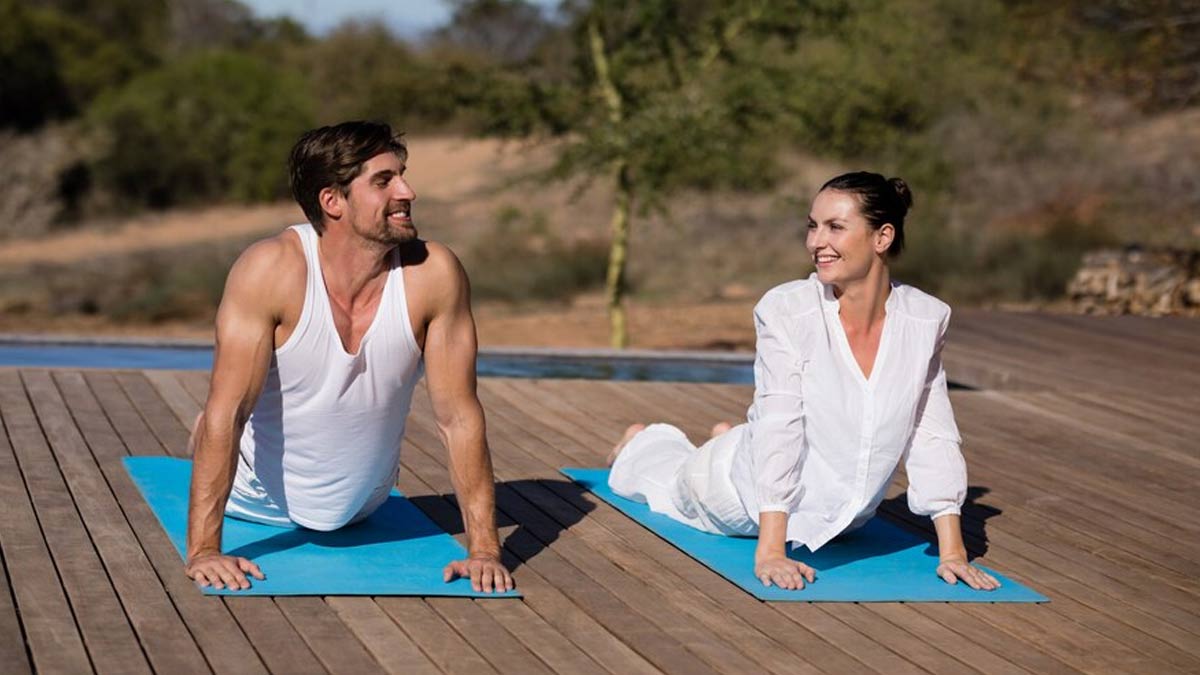
AcroYoga is a combination of acrobatics, yoga, and therapeutic techniques that involve two or more people working together to perform various poses and sequences. It focuses on trust, communication, and connection between partners, and it can be practiced as a form of exercise, meditation, or even artistic expression.
Table of Content:-
In AcroYoga, there are typically two roles: the base and the flyer. The base is the person who remains in contact with the ground and provides stability and support, while the flyer is the person who is lifted off the ground and performs various aerial poses.
Benefits of AcroYoga include improved strength, flexibility, balance, coordination, and body awareness. It also fosters trust, communication, teamwork, and connection with others. Additionally, practicing AcroYoga can be a joyful and uplifting experience, combining physical challenges with a sense of playfulness and exploration.

Acro Yoga Poses for Beginners
If you are interesting in starting AcroYoga with your partner, and don’t know how to begin, here are a few beginner friendly poses you can try:
Flying Low
This pose involves the base lying on their back with knees bent, and the flyer standing facing the base's feet. The flyer then places their hands on the base's knees and leans forward, lifting their feet off the ground to balance.
Front Bird
The base sits with legs extended, leaning back slightly for support. The flyer sits on the base's feet facing away, leaning back to grasp the base's ankles. The flyer then extends their legs, creating a ‘front bird’ position.
Back Bird
Similar to Front Bird, but the flyer faces towards the base and holds onto the base's wrists or forearms. The base supports the flyer's back as it leans back into a comfortable position. This pose improves backbend flexibility and teamwork.
Star Pose
The base lies on their back with legs raised, forming a 90-degree angle with their torso. The flyer stands facing the base's feet, places their hands on the base's ankles, and extends their body outward to create a star shape. This pose requires balance and coordination.
Throne Pose
The base sits with legs bent and feet flat on the ground. The flyer sits on the base's feet facing forward, wraps their arms around the base's neck, and extends their legs outward. This pose emphasises trust and stability.
Also Read: From Strengthening Your Relationship To Physical Fitness, Here’s Why Couples Should Try Acro Yoga

Tips for Beginners in Acro Yoga
While these poses may not seem that difficult or complex, still it is advisable that you exercise the following considerations or precautions before you get a hang of AcroYoga:
Start Slow: Begin with simple poses and gradually progress to more challenging ones as you build strength, trust, and coordination with your partner.
Communicate Clearly: Use verbal cues and hand signals to communicate your intentions, needs, and comfort level during poses. Trust and open communication are key in Acro Yoga.
Focus on Alignment: Pay attention to proper alignment and engagement of muscles to ensure safety and stability in poses. Work on core strength and balance to support your partner effectively.
Use Spotters: If you're new to Acro Yoga, have a spotter or experienced practitioner nearby to provide guidance, assistance, and safety during practice.
Practice Mindfulness: Stay present in the moment, focus on your breath, and cultivate mindfulness to enhance your connection with your partner and the practice of Acro Yoga.
Also Read: Acro Yoga: Perform These Asanas To Increase Strength
Practicing AcroYoga as a couple can promote trust, communication, intimacy, stress relief, shared experiences, and physical well-being, contributing to a stronger, more fulfilling relationship. Including these poses and tips for beginners can help you to learn the basics of Acro Yoga and explore this enriching practice with your partner.
Also watch this video
Read Next
From Strengthening Your Relationship To Physical Fitness, Here’s Why Couples Should Try Acro Yoga
How we keep this article up to date:
We work with experts and keep a close eye on the latest in health and wellness. Whenever there is a new research or helpful information, we update our articles with accurate and useful advice.
Current Version